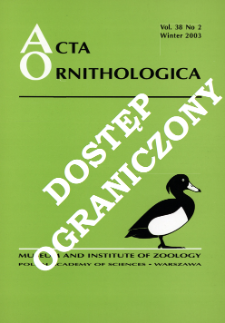
Obiekt
Tytuł: Reversible size-changes in stomachs of shorebirds: when, to what extent and why?
Twórca:
Piersma, Theunis ; Dietz, Maurine W. ; Dekinga, Anne ; Nebel, Silke ; Gils, Jan van ; Battley, Phil F. ; Spaans, Bernard
Data wydania/powstania:
Typ zasobu:
Inny tytuł:
Acta Ornithologica, vol. 34, no. 2 ; Odwracalność zmian wielkości żołądka ptaków brodzących: kiedy, w jakim stopniu i dlaczego? ; Flexible stomach of shorebirds
Współtwórca:
Polska Akademia Nauk. Muzeum i Instytut Zoologii ; Meeting of the European Ornithologists' Union (2 ; 1999 ; Gdańsk)
Wydawca:
Muzeum i Instytut Zoologii PAN
Miejsce wydania:
Opis:
Referat wygłoszony na Second Meeting of the European Ornithologists' Union ; Bibliogr. s. 180-181 ; S. [175]-181 : il. ; 27 cm ; Streszcz. pol. Nazwy taksonów także w jęz. łac.
Typ obiektu:
Abstrakt:
Shorebirds show large interspecific variation in the relative size of the stomach, and especially of the muscular part, the gizzard. Much of this variation can be explained by their diet. Species feeding mainly on hard-shelled prey such as bivalves and gastropods have large stomachs; those feeding on soft-bodied prey such as worms have small stomachs. Within a species, diet- and migration-induced changes in stomach size can occur. Our studies on this intraspecific variation have focused on two mollusc-specialists, the Red Knot Calidris canutus and the Great Knot C. tenuirostris. Both are renowned for long-range flights between their arctic or sub-arctic alpine breeding grounds and a variety of coastal wetlands. Feeding mainly on shellfish ingested whole, both knot species have large stomachs, but changing diets easily lead to apparently adaptive modifications. In addition, the demands imposed by flights of many thousand kilometres may induce reductions in stomach size. Using ultrasonography we have begun to experimentally disentangle the causal relationships between diet, season and stomach size in Red Knots. A soft diet can induce stomach reductions of 50% within a week, and such changes are reversible. Studies on radiomarked birds in the Wadden Sea emphasize that variations in stomach size are correlated with prey and patch choice in the field.
Czasopismo/Seria/cykl:
Tom:
Zeszyt:
Strona pocz.:
Strona końc.:
Szczegółowy typ zasobu:
Artykuł ; Materiały konferencyjne
Format:
Identyfikator zasobu:
Źródło:
MiIZ PAN, patrz sygn. czas. P.257, Vol. 34, No 2 ; MiIZ PAN, patrz sygn. czas. P.4568, Vol. 34, No 2 ; kliknij tutaj, żeby przejść
Język:
Prawa:
Prawa zastrzeżone - dostęp ograniczony
Zasady wykorzystania:
Digitalizacja:
Muzeum i Instytut Zoologii Polskiej Akademii Nauk
Lokalizacja oryginału:
Biblioteka Muzeum i Instytutu Zoologii PAN
Dofinansowane ze środków:
Program Operacyjny Innowacyjna Gospodarka, lata 2010-2014, Priorytet 2. Infrastruktura strefy B + R ; Unia Europejska. Europejski Fundusz Rozwoju Regionalnego
Dostęp:
Kolekcje, do których przypisany jest obiekt:
- Muzeum i Instytut Zoologii PAN > Czasopisma
- Muzeum i Instytut Zoologii PAN > Wydawnictwa MiIZ PAN > Acta Ornithologica
Data ostatniej modyfikacji:
2 paź 2020
Data dodania obiektu:
20 maj 2014
Liczba pobrań / odtworzeń:
42
Wszystkie dostępne wersje tego obiektu:
https://rcin.org.pl/miiz/publication/61248
Wyświetl opis w formacie RDF:
Wyświetl opis w formacie RDFa:
Wyświetl opis w formacie OAI-PMH:
| Nazwa wydania | Data |
|---|---|
| Reversible size-changes in stomachs of shorebirds: when, to what extent and why? / Piersma, Theunis | 2 paź 2020 |
Obiekty Podobne
Gromadzka, Jadwiga
Gallo-Orsi, Umberto Boere, Gerard
Zając, Ryszard Zygmunt (1936– )
Rehfisch, Marc Mansel Austin, Graham E. Clark, Nigel A. Clarke, Ralph T. Holloway, Steve J. Yates, Mick G. Dit Durell, Sarah E. A. le V. Eastwood, Jim A. Goss-Custard, John D. Swetnam, Ruth D. West, John R.
Król, Elżbieta
Józefik, Mieczysław (1930– ) Swirski, Zbigniew (1926– )
Starck, Johannes Matthias (1958– )
Jenni, Lukas

 INSTYTUT ARCHEOLOGII I ETNOLOGII POLSKIEJ AKADEMII NAUK
INSTYTUT ARCHEOLOGII I ETNOLOGII POLSKIEJ AKADEMII NAUK
 INSTYTUT BADAŃ LITERACKICH POLSKIEJ AKADEMII NAUK
INSTYTUT BADAŃ LITERACKICH POLSKIEJ AKADEMII NAUK
 INSTYTUT BADAWCZY LEŚNICTWA
INSTYTUT BADAWCZY LEŚNICTWA
 INSTYTUT BIOLOGII DOŚWIADCZALNEJ IM. MARCELEGO NENCKIEGO POLSKIEJ AKADEMII NAUK
INSTYTUT BIOLOGII DOŚWIADCZALNEJ IM. MARCELEGO NENCKIEGO POLSKIEJ AKADEMII NAUK
 INSTYTUT BIOLOGII SSAKÓW POLSKIEJ AKADEMII NAUK
INSTYTUT BIOLOGII SSAKÓW POLSKIEJ AKADEMII NAUK
 INSTYTUT CHEMII FIZYCZNEJ PAN
INSTYTUT CHEMII FIZYCZNEJ PAN
 INSTYTUT CHEMII ORGANICZNEJ PAN
INSTYTUT CHEMII ORGANICZNEJ PAN
 INSTYTUT FILOZOFII I SOCJOLOGII PAN
INSTYTUT FILOZOFII I SOCJOLOGII PAN
 INSTYTUT GEOGRAFII I PRZESTRZENNEGO ZAGOSPODAROWANIA PAN
INSTYTUT GEOGRAFII I PRZESTRZENNEGO ZAGOSPODAROWANIA PAN
 INSTYTUT HISTORII im. TADEUSZA MANTEUFFLA POLSKIEJ AKADEMII NAUK
INSTYTUT HISTORII im. TADEUSZA MANTEUFFLA POLSKIEJ AKADEMII NAUK
 INSTYTUT JĘZYKA POLSKIEGO POLSKIEJ AKADEMII NAUK
INSTYTUT JĘZYKA POLSKIEGO POLSKIEJ AKADEMII NAUK
 INSTYTUT MATEMATYCZNY PAN
INSTYTUT MATEMATYCZNY PAN
 INSTYTUT MEDYCYNY DOŚWIADCZALNEJ I KLINICZNEJ IM.MIROSŁAWA MOSSAKOWSKIEGO POLSKIEJ AKADEMII NAUK
INSTYTUT MEDYCYNY DOŚWIADCZALNEJ I KLINICZNEJ IM.MIROSŁAWA MOSSAKOWSKIEGO POLSKIEJ AKADEMII NAUK
 INSTYTUT PODSTAWOWYCH PROBLEMÓW TECHNIKI PAN
INSTYTUT PODSTAWOWYCH PROBLEMÓW TECHNIKI PAN
 INSTYTUT SLAWISTYKI PAN
INSTYTUT SLAWISTYKI PAN
 SIEĆ BADAWCZA ŁUKASIEWICZ - INSTYTUT TECHNOLOGII MATERIAŁÓW ELEKTRONICZNYCH
SIEĆ BADAWCZA ŁUKASIEWICZ - INSTYTUT TECHNOLOGII MATERIAŁÓW ELEKTRONICZNYCH
 MUZEUM I INSTYTUT ZOOLOGII POLSKIEJ AKADEMII NAUK
MUZEUM I INSTYTUT ZOOLOGII POLSKIEJ AKADEMII NAUK
 INSTYTUT BADAŃ SYSTEMOWYCH PAN
INSTYTUT BADAŃ SYSTEMOWYCH PAN
 INSTYTUT BOTANIKI IM. WŁADYSŁAWA SZAFERA POLSKIEJ AKADEMII NAUK
INSTYTUT BOTANIKI IM. WŁADYSŁAWA SZAFERA POLSKIEJ AKADEMII NAUK
































